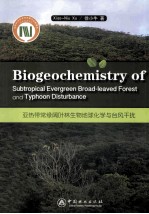

亚热带常绿阔叶林生物地球化学与台风干扰 英文PDF电子书下载
- 电子书积分:10 积分如何计算积分?
- 作 者:徐小牛著
- 出 版 社:北京:中国林业出版社
- 出版年份:2013
- ISBN:9787503871900
- 页数:208 页
1. Introduction 1
1.1 Characteristics of the Okinawan Evergreen Broad-leaved Forest and Its Importance for Sustainable Management 1
1.2 Overview of Nutrient Cycling in Forest Ecosystems 2
1.3 Effects of Typhoon Disturbances on Forest Ecosystems 5
1.4 Motives for the Present Synthesis 7
1.5 The Contents and Organization of the Book 8
1.6 Summary 10
2. Study Site Characterization 11
2.1 Study Area 11
2.2 Climate 11
2.3 Topographic Trait and Soils 13
2.4 Vegetation 14
3. Soil Properties, Organic Carbon, and Nutrient Pools 15
3.1 Introduction 15
3.2 Study Approach 16
3.2.1 Forest Floor and Mineral Soil Sampling 17
3.2.2 Experimental Design in the Study 18
3.2.3 Statistical Analysis and Data Treatment 19
3.3 Forest Floor Mass and Carbon and Nutrient Pools 20
3.3.1 Carbon and Nutrient Pools 20
3.3.2 Topographic Effects 22
3.4 Soil Properties and Carbon and Nutrient Pools 23
3.4.1 Soil Properties 23
3.4.2 Carbon and Nutrient Pools 27
3.4.3 Cluster Analysis of Soil Data 28
3.5 Summary 30
4. Forest Structure, Species Diversity, Regeneration and Primary production 31
4.1 Introduction 31
4.2 Experimental Approach 33
4.2.1 Field Survey 33
4.2.2 Species Diversity Indices 36
4.2.3 Forest Biomass Estimation 37
4.3 Forest Structure and Floristics 42
4.3.1 Structural Characteristics 42
4.3.2 Floristic Composition and Tree Species Diversity 44
4.3.3 Understory Tree Species Diversity 46
4.3.4 Controls of Species Diversity 47
4.3.5 Discussion of Species Diversity 47
4.4 Forest Regeneration Characteristics 49
4.4.1 Stand Density 49
4.4.2 Regeneration Strategies of Canopy Dominants 50
4.4.3 Restoration of Stand Structure 53
4.5 Aboveground Biomass and Nutrient Accumulation 55
4.5.1 Aboveground Biomass 55
4.5.2 Carbon and Nutrient Storage in Biomass 57
4.5.3 Discussion on Biomass Estimation and Nutrient Storage 59
4.6 Summary 60
5. Organic Matter and Nutrient Dynamics in Litter Production 62
5.1 Introduction 62
5.2 Approaches to Forest Litterfall Measurement 63
5.2.1 Litterfall Measurement 63
5.2.2 Chemical Analysis 66
5.2.3 Data Treatment 67
5.3 Litterfall Production 67
5.3.1 Amount and Seasonality of Litterfall 67
5.3.2 Nutrient Inputs by Litterfall 72
5.4 Effects of Typhoon Disturbance on Litterfall and Related Nutrient Input 76
5.5 Discussion 79
5.5.1 Litter Production 79
5.5.2 Nutrient Concentration and Inputs 81
5.5.3 Nutrient Use Efficiency in Litter Production 82
5.5.4 Effects of Typhoon Disturbances 84
5.6 Summary 85
6. Carbon and Nutrient Dynamics in Decomposing Foliar Litter 87
6.1 Introduction 87
6.2 Factors Affecting the Decomposition Process 89
6.2.1 Litter Quality 89
6.2.2 Climate 90
6.2.3 Site-specific Variables 91
6.2.4 Human Activity 92
6.3 Approaches to the Study of Litter Decomposition 92
6.3.1 Mass Balance Method 92
6.3.2 Litterbag Method 93
6.3.3 Experimental Design in the Study 94
6.3.4 Chemical Analysis 96
6.3.5 Data Analysis 97
6.4 Nutrients Dynamics in Decomposing Foliar Litter 97
6.4.1 Weight Loss and Decomposition Rate 97
6.4.2 Initial Foliar Litter Quality 101
6.4.3 Nutrient Dynamics 101
6.5 Discussion 107
6.5.1 Dry Mass Loss and Decomposition Rate 107
6.5.2 Initial Litter Quality and Nutrient Dynamics 108
6.6 Summary 115
7. Nutrient Fluxes in Precipitation, Throughfall, Stemflow and Soil Water 117
7.1 Introduction 117
7.2 Methodology of Study of Forest Hydrology 119
7.2.1 Research Forest Stand 119
7.2.2 Hydrological Measurements 120
7.2.3 Chemical Analysis 122
7.2.4 Data Analysis 123
7.3 Rainfall Partitioning 123
7.3.1 Precipitation and Canopy Interception 123
7.3.2 Surface Runoff and Soil Lateral Flow 126
7.4 Nutrient Fluxes 128
7.4.1 Precipitation, Throughfall and Stemflow 128
7.4.2 Soil Water 131
7.5 Discussion 132
7.5.1 Distribution of Rainfall Components 132
7.5.2 Nutrient Inputs in Precipitation 135
7.6 Summary 138
8. Effects of Typhoon Disturbances on Stream Water Chemistry 139
8.1 Introduction 139
8.2 Methodology in the Study 140
8.3 Temporal Patterns of Stream Water Chemistry 141
8.3.1 Physicochemical Properties of Stream Water 141
8.3.2 Temporal Patterns of Streamwater Chemistry 143
8.3.3 Average Streamwater Concentrations During and After Typhoon Season 147
8.4 Discussion 148
8.4.1 Controls of Streamwater Chemistry 148
8.4.2 Effects of Typhoon Disturbance on Streamwater Chemistry 150
8.5 Summary 152
9. Integration and Opportunities 153
9.1 Within Stand Nutrient Cycling, Nutrient Transfer Pathway, and Nutrient Use Efficiency 153
9.1.1 Nutrient Cycling within the Ecosystem 153
9.1.2 Nutrient Transfer Pathway 157
9.1.3 Nutrient Use Efficiency 158
9.2 Effects of Typhoon Disturbance on Nutrient Cycling 160
9.3 Control of Forest Structure and Productivity 163
9.4 Future Opportunities 167
9.5 Summary 169
References 171
Appendix Ⅰ 205
Appendix Ⅱ 207
- 《分析化学》陈怀侠主编 2019
- 《化学反应工程》许志美主编 2019
- 《危险化学品经营单位主要负责人和安全生产管理人员安全培训教材》李隆庭,徐一星主编 2012
- 《奶制品化学及生物化学》(爱尔兰)福克斯(FoxP.F.)等 2019
- 《有机化学实验》雷文 2015
- 《全国普通高等中医药院校药学类专业十三五规划教材 第二轮规划教材 分析化学实验 第2版》池玉梅 2018
- 《生物化学》田余祥主编 2020
- 《长江口物理、化学与生态环境调查图集》于非 2019
- 《美国小学分级阅读 二级D 地球科学&物质科学》本书编委会 2016
- 《化学工程与工艺专业实验指导》郭跃萍主编 2019
- 《中风偏瘫 脑萎缩 痴呆 最新治疗原则与方法》孙作东著 2004
- 《水面舰艇编队作战运筹分析》谭安胜著 2009
- 《王蒙文集 新版 35 评点《红楼梦》 上》王蒙著 2020
- 《TED说话的力量 世界优秀演讲者的口才秘诀》(坦桑)阿卡什·P.卡里亚著 2019
- 《燕堂夜话》蒋忠和著 2019
- 《经久》静水边著 2019
- 《魔法销售台词》(美)埃尔默·惠勒著 2019
- 《微表情密码》(波)卡西亚·韦佐夫斯基,(波)帕特里克·韦佐夫斯基著 2019
- 《看书琐记与作文秘诀》鲁迅著 2019
- 《酒国》莫言著 2019
- 《中国当代乡土小说文库 本乡本土》(中国)刘玉堂 2019
- 《异质性条件下技术创新最优市场结构研究 以中国高技术产业为例》千慧雄 2019
- 《中国铁路人 第三届现实主义网络文学征文大赛一等奖》恒传录著 2019
- 《莼江曲谱 2 中国昆曲博物馆藏稀见昆剧手抄曲谱汇编之一》郭腊梅主编;孙伊婷副主编;孙文明,孙伊婷编委;中国昆曲博物馆编 2018
- 《中国制造业绿色供应链发展研究报告》中国电子信息产业发展研究院 2019
- 《中国陈设艺术史》赵囡囡著 2019
- 《指向核心素养 北京十一学校名师教学设计 英语 七年级 上 配人教版》周志英总主编 2019
- 《《走近科学》精选丛书 中国UFO悬案调查》郭之文 2019
- 《清至民国中国西北戏剧经典唱段汇辑 第8卷》孔令纪 2018
- 《北京生态环境保护》《北京环境保护丛书》编委会编著 2018
